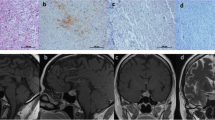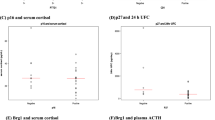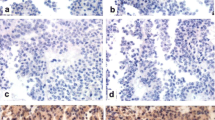Abstract
The molecular mechanisms underlying the formation of nonfunctioning pituitary adenomas (NFAs) are largely unknown. In this study, we aimed to understand the relationship between NFAs and functional pituitary adenomas and the possible role of proteins involved in cell cycle, senescence, and DNA damage control mechanisms in the etiology of NFA. We analyzed pATM-S1981, pRb-S608, Rb, pE2F1-S364, p16, E2F1, p73, cyclin D1, and CHEK2 protein expression (in a group of 20 patients with acromegaly, 18 patients with Cushing’s disease (CD), and 29 NFA patients) by immunohistochemistry and their relevant mRNA expression by qRT-PCR (in a group of 7 patients with acromegaly, 7 patients with CD, and 7 NFA patients). The clinical and histopathological results on the patients were statistically evaluated. pE2F1-S364 protein expression in the CD group was significantly lower than that in the NFA and acromegaly groups (p = 0.025, p = 0.034, respectively). However, the expression of the p16 protein was lower than in the NFA group than in the CD and acromegaly groups (p = 0.030, p = 0.033, respectively), and E2F1 protein expression was significantly higher in the NFA group than in the CD group (p = 0.025). p73 protein expression in patients with acromegaly was significantly higher (p = 0.031) than that in the CD group. CHEK2 mRNA expression in the CD group was significantly higher than that in the acromegaly group (p = 0.012). The selective and tumor-specific associations between E2F1, pE2F1-S364, CHEK2, and p73 mRNA and protein levels indicate their involvement in pituitary adenoma formation in NFA, CD, and acromegaly patients.








Similar content being viewed by others
Abbreviations
- ACTH:
-
adrenocorticotropic hormone
CD
Cushing’s disease
CDK
cyclin-dependent kinases
FSH
follicle-stimulating hormone
GH
growth hormone
LH
luteinizing hormone
NFA
nonfunctioning pituitary adenomas
References
Melmed S (2011) Pathogenesis of pituitary tumors. Nat Rev Endocrinol 7(5): p. 257-266.
Kovacs K, E Horvath, and S Vidal (2001) Classification of pituitary adenomas. J Neurooncol 54(2): p. 121-127.
Melmed S (2003) Mechanisms for pituitary tumorigenesis: the plastic pituitary. J Clin Invest 112(11): p. 1603-1618.
Young WF Jr, Scheithauer BW, Kovacs KT et al (1996) Gonadotroph adenoma of the pituitary gland: a clinicopathologic analysis of 100 cases. Mayo Clin Proc 71(7): p. 649-656.
Moreno CS, Evans CO, Zhan X, Okor M, Desiderio DM, Oyesiku NM (2005) Novel molecular signaling and classification of human clinically nonfunctional pituitary adenomas identified by gene expression profiling and proteomic analyses. Cancer Res 65(22): p. 10214-22.
Zhan X, et al (2014) Heterogeneity analysis of the proteomes in clinically nonfunctional pituitary adenomas. BMC Med Genomics 7: p. 69.
Schmitt CA et al (2002) A senescence program controlled by p53 and p16INK4a contributes to the outcome of cancer therapy. Cell 109(3): p. 335-346.
Lee EH, Kim KH, Kwon JH, Kim HD, Kim YZ (2014) Results of immunohistochemical staining of cell-cycle regulators: the prediction of recurrence of functioning pituitary adenoma. World Neurosurg 81(3-4): p. 563-575.
Chesnokova V et al (2011) Lineage-specific restraint of pituitary gonadotroph cell adenoma growth. PLoS One 6(3): p. e17924.
Carnevale J et al (2012) DNA damage signals through differentially modified E2F1 molecules to induce apoptosis. Mol Cell Biol 32(5): p. 900-912.
Araki T, Liu NA, Tone Y, Cuevas-Ramos D, Heltsley R, Tone M, Melmed S (2016) E2F1-mediated human POMC expression in ectopic Cushing’s syndrome. Endocr Relat Cancer 23(11): p. 857-870.
Zhou C, Wawrowsky K, Bannykh S, Gutman S, Melmed S (2009) E2F1 induces pituitary tumor transforming gene (PTTG1) expression in human pituitary tumors. Mol Endocrinol 23(12): p. 2000-12.
Fedele M et al (2006) E2F1 activation is responsible for pituitary adenomas induced by HMGA2 gene overexpression. Cell Div 1: p. 17.
Ozkaya HM, Comunoglu N, Sayitoglu M, Keskin FE, Firtina S, Khodzhaev K, Apaydin T, Gazioglu N, Tanriover N, Oz B, Kadioglu P (2018) Germline mutations of aryl hydrocarbon receptor-interacting protein (AIP) gene and somatostatin receptor 1-5 and AIP immunostaining in patients with sporadic acromegaly with poor versus good response to somatostatin analogues. Pituitary 21(4): p. 335-346.
Kaya-Dagistanli F, Tanriverdi G, Altinok A, Ozyazgan S, Ozturk M (2013) The effects of alpha lipoic acid on liver cells damages and apoptosis induced by polyunsaturated fatty acids. Food Chem Toxicol 53: p. 84-93.
Tani Y, Inoshita N, Sugiyama T, Kato M, Yamada S, Shichiri M, Hirata Y (2010) Upregulation of CDKN2A and suppression of cyclin D1 gene expressions in ACTH-secreting pituitary adenomas. Eur J Endocrinol 163(4): p. 523-529.
Attwooll C, E Lazzerini Denchi, and K Helin (2004) The E2F family: specific functions and overlapping interests. EMBO J 23(24): p. 4709-4716.
Simpson D.J et al (2000) Loss of pRb expression in pituitary adenomas is associated with methylation of the RB1 CpG island. Cancer Res 60(5): p. 1211-1216.
Indovina P, Pentimalli F, Casini N, Vocca I, Giordano A (2015) RB1 dual role in proliferation and apoptosis: cell fate control and implications for cancer therapy. Oncotarget 6(20): p. 17873-17890.
van den Heuvel S. and N.J Dyson (2008) Conserved functions of the pRB and E2F families. Nat Rev Mol Cell Biol 9(9): p. 713-724.
Geoffrey M Cooper, REH (2015) The Cell Cycle in The Cell: A Molecular Approach Sİnauer Associates.: Washington, D.C
Bae WK, Hong CS, Park MR, Sun EG, Lee JH, Kang K, Ryu KH, Shim HJ, Hwang JE, Cho SH, Chung IJ (2018) TAp73 inhibits cell invasion and migration by directly activating KAI1 expression in colorectal carcinoma. Cancer Lett 415: p. 106-116.
Roussel-Gervais A et al (2016) The Cables1 Gene in Glucocorticoid Regulation of Pituitary Corticotrope Growth and Cushing Disease. J Clin Endocrinol Metab 101(2): p. 513-522.
Bird AD, Tan KH, Olsson PF, Zieba M, Flecknoe SJ, Liddicoat DR, Mollard R, Hooper SB, Cole TJ (2007) Identification of glucocorticoid-regulated genes that control cell proliferation during murine respiratory development. J Physiol 585(Pt 1): p. 187-201.
Acknowledgments
We are deeply grateful to Dr. Shlomo Melmed and all of his laboratory members at Cedars-Sinai Medical Center for their support and valuable recommendations.
Funding
The study was supported by the Research Fund of the Istanbul University, Istanbul, Turkey (project # 2017-25404)
Author information
Authors and Affiliations
Corresponding author
Ethics declarations
The authors declare that they have no conflict of interest.
Ethical Approval
This study was approved by the Clinical Research Ethics Committee of Cerrahpaşa Medical School, Istanbul University, with the number 06/04/2017-133989. Written informed consent was obtained at the beginning of the study from all the patients.
All procedures involving human participants were performed in accordance with the ethical standards of the institutional research committee and of the 1964 Helsinki Declaration and its later amendments or comparable ethical standards
Additional information
Publisher’s Note
Springer Nature remains neutral with regard to jurisdictional claims in published maps and institutional affiliations.
Rights and permissions
About this article
Cite this article
Metin-Armagan, D., Comunoglu, N., Bulut, G. et al. A Novel Expression Profile of Cell Cycle and DNA Repair Proteins in Nonfunctioning Pituitary Adenomas. Endocr Pathol 31, 2–13 (2020). https://doi.org/10.1007/s12022-019-09598-x
Published:
Issue Date:
DOI: https://doi.org/10.1007/s12022-019-09598-x




